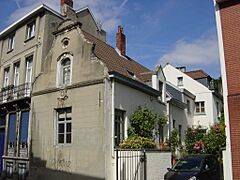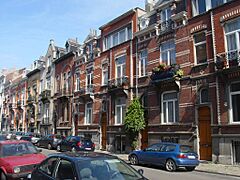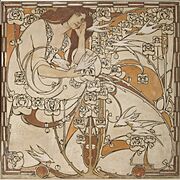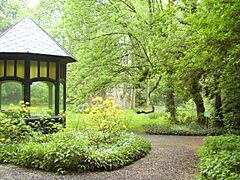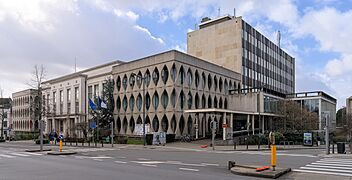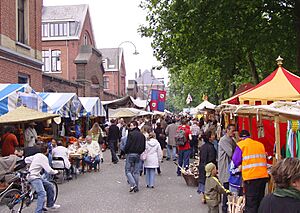Etterbeek facts for kids
Quick facts for kids
Etterbeek
|
|||
|---|---|---|---|
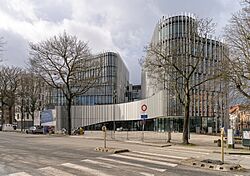
Etterbeek's Municipal Hall
|
|||
|
|||
| Country | Belgium | ||
| Community | Flemish Community French Community |
||
| Region | Brussels | ||
| Arrondissement | Brussels-Capital | ||
| Area | |||
| • Total | 3.15 km2 (1.22 sq mi) | ||
| Population
(2018-01-01)Lua error in Module:Wd at line 1575: attempt to index field 'wikibase' (a nil value).
|
|||
| • Total | Lua error in Module:Wd at line 1,575: attempt to index field 'wikibase' (a nil value). | ||
| Postal codes |
1040
|
||
| Area codes | 02 | ||
| Website | www.etterbeek.be/fr www.etterbeek.be/nl |
||
Etterbeek is one of the 19 towns that make up the Brussels-Capital Region in Belgium. It is located in the eastern part of the region.
Etterbeek shares borders with other towns like Auderghem, the City of Brussels, Ixelles, Schaerbeek, Woluwe-Saint-Lambert, and Woluwe-Saint-Pierre. Like all towns in Brussels, it is officially bilingual, meaning both French and Dutch are spoken here.
Contents
History
How Etterbeek Started
Legend says that Saint Gertrude of Nivelles built a small church here in the 700s. A paper from Holy Roman Emperor Otto I in 966 mentions a church called Iatrebache.
The name Ietrebecca first appeared in a document from 1127. It might come from an old Celtic word ett, meaning "fast movement," and the Dutch word beek, meaning "stream." The way we spell Etterbeek today first showed up in 1138. Around that time, a new and bigger church was built.
Etterbeek in the Middle Ages
During the Middle Ages, Etterbeek was a small farming village. It was mostly independent from Brussels. However, Brussels did have the right to tax beer made in Etterbeek around the year 1300.
The next two centuries were tough for Etterbeek. In 1489, Duke Albert III of Saxony attacked and damaged Etterbeek. This happened while he was chasing rebels. In 1580, the village was destroyed again. This time, it was by people who broke religious images during the Protestant Reformation wars. Peace returned when Archdukes Albert VII and Isabella ruled.
Becoming a Barony and a Municipality
In 1673, Etterbeek became independent from its neighbor, Sint-Genesius-Rode. This happened when King Charles II of Spain made it a barony. The first baron was Don Diego-Henriquez de Castro. He was the main treasurer for the armies in the Netherlands.
The Castro family house was sold in 1767. You can still see it today; it is the oldest building in Etterbeek.
Under French rule, Etterbeek became a commune (a type of local government area). This was part of the canton of Sint-Stevens-Woluwe. After this, and especially after the Belgian Revolution in 1830, Etterbeek grew quickly. Brussels was becoming a capital city, and more people moved to Etterbeek.
In 1876, over 10,000 people lived there. By 1900, the number was more than 20,000. In 1910, it reached over 33,000. In the early 1900s, during the time of King Leopold II, a lot of building happened. This changed the town's look with wide avenues and new homes that you can still see today.
Places to See
- Etterbeek has two Roman Catholic churches. These are the Church of Saint Anthony of Padua and the Church of Our Lady of the Sacred Heart. A third church, the Church of Saint Gertrude, was taken down in 1993 because it was about to fall apart.
- The Cauchie House was built in 1905. It was designed by Paul Cauchie, an Art Nouveau architect and artist. Its front is special because of its allegorical sgraffiti (pictures scratched into plaster).
- The Barony House is very different. It was built in 1680 and is the oldest building in Etterbeek.
- The Chaussée de Wavre/Waversesteenweg street has cool large drawings. These are from the Le Chat cartoon by Philippe Geluck. He was born and grew up in this area. The 24 drawings stretch for about 120 meters.
- Etterbeek has some nice green spaces. One is the Jean-Félix Hap Garden. The well-known Parc du Cinquantenaire/Jubelpark is partly in Etterbeek and partly in the City of Brussels. Leopold Park is also very close to Etterbeek.
The main campus of Vrije Universiteit Brussel (VUB) is called Campus Etterbeek. But it's actually located in the nearby town of Ixelles, not Etterbeek itself.
Population Facts
Etterbeek has many people who have moved there from other countries. Both people from the European Union and from outside Europe make up a larger group than native Belgians. Like nearby Ixelles and Schaerbeek, Etterbeek also has a large Muslim population. Many of these people are from North Africa.
The table below shows where people living in Etterbeek came from in 2023:
| Group of origin | Year | |
|---|---|---|
| 2023 | ||
| Number | % | |
| Belgians with Belgian background | 11,169 | 22.54% |
| Belgians with foreign background | 13,191 | 26.62% |
| Neighbouring country | 1,695 | 3.42% |
| EU27 (excluding neighbouring country) | 2,207 | 4.45% |
| Outside EU 27 | 9,289 | 18.74% |
| Non-Belgians | 25,198 | 50.85% |
| Neighbouring country | 6,233 | 12.58% |
| EU27 (excluding neighboring country) | 11,734 | 23.68% |
| Outside EU 27 | 7,231 | 14.59% |
| Total | 49,558 | 100% |
Getting Around
Etterbeek has its own Etterbeek railway station. It also has one railway station called Mérode. There are three metro stations: Mérode, Thieffry, and Pétillon.
Sports
- Etterbeek is home to two football clubs: R.R.C. Etterbeek and Armenia. They play in the Belgian Provincial leagues at the Guy Thys Stadium. This stadium was named after the famous Belgian football manager in 2003. Guy Thys led the Belgium national football team to fourth place in the 1986 FIFA World Cup.
- The town's swimming pool burned down in 1996. It has since been rebuilt and is now open for everyone to use again.
Events
Etterbeek holds a medieval market every year. It used to be held at the end of May on Avenue du 2ème Régiment de Lanciers/2de Lansiers Regimentlaan. In recent years, it has taken place at the Cinquantenaire park.
Famous People
Born in Etterbeek:
- Jérôme d'Ambrosio (born 1985), racing driver
- Jean Brachet (1909–1998), biochemist (studies living things' chemistry)
- Misha Defonseca (Monique De Wael) (born 1937), writer
- Pierre Deligne (born 1944), mathematician who won the Fields Medal
- François Englert (born 1932), physicist who won the Nobel Prize
- Giani Esposito (1930–1974), actor
- Lara Fabian (born 1970), singer-songwriter
- Annie Fargé (1934–2011), actress
- Marouane Fellaini (born 1987), footballer
- Philippe Francq (born 1961), cartoonist
- André Franquin (1924–1997), cartoonist, created Gaston and Marsupilami
- Philippe Geluck (born 1954), cartoonist, created Le Chat
- Georges Grün (born 1962), football defender
- Arthur Maurice Hocart (1883–1939), anthropologist (studies human societies and cultures)
- Daniel Hulet (1942–2011), cartoonist
- René Kalisky (1936–1981), playwright and writer
- Michel Ledent, also known as Midam (born 1963), cartoonist
- Roland Lethem (born 1942), filmmaker and writer
- Charles Lambert Manneback (1894–1975), physicist and mathematician
- Alexandre de Merode (1934–2002), member of the International Olympic Committee (IOC)
- Constantin Meunier (1831–1905), painter and sculptor
- Eliane Morissens (1927–2006), activist for LGBT rights
- Fabrice Mvemba (born 1980), footballer
- Amélie Nothomb (born 1966), writer
- Charles Picqué (born 1948), politician and mayor
- Godelieve Quisthoudt-Rowohl (born 1947), German politician
- Georges Remi, also known as Hergé (1907–1983), cartoonist, created The Adventures of Tintin
- Andre Sapir (born 1950), economist
- Stromae (Paul Van Haver) (born 1985), singer-songwriter and rapper
- Herman Van Rompuy (born 1947), politician, former Prime Minister, and first permanent President of the European Council
Lived part of their life in Etterbeek:
- Jean Absil (1893–1974), composer and organist
- Jean-Baptiste Baronian (born 1942), Belgian-Armenian writer
- René Carcan (1925–1993), engraver and sculptor
- Adrien de Gerlache (1866–1934), officer of the Belgian Navy and leader of the Belgian Antarctic Expedition
- Luigi Di Maio (born 1986), Italian Minister of Foreign Affairs
- W.F. Hermans (1921–1995), Dutch writer
- Edgar Pierre Jacobs (1904–1987), cartoonist, created Blake and Mortimer
- Gaston Salmon (1878–1917), épée fencer, Olympic champion
Buried in Etterbeek:
- Moise Tshombe (1919–1969), Congolese politician
Etterbeek's Sister Cities
Etterbeek has special partnerships with other towns around the world. These are called twin towns or sister cities:
 Fontenay-sous-Bois, France
Fontenay-sous-Bois, France Forte dei Marmi, Italy
Forte dei Marmi, Italy Beauport, Quebec, Canada
Beauport, Quebec, Canada Essaouira, Morocco
Essaouira, Morocco
See also
 In Spanish: Etterbeek para niños
In Spanish: Etterbeek para niños







